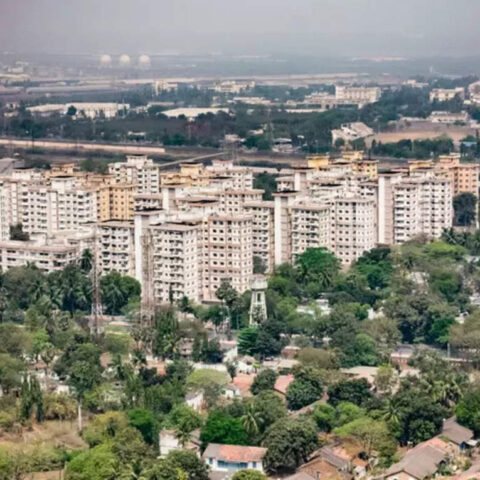The New York skyline is certainly one of the world’s most recognizable. The Big Apple is known for its many impressive architectural firsts and—in the opinion of critic Eric P. Nash, author of forthcoming book Sky-High: A Critique of NYC’s Supertall Towers from Top to Bottom (Princeton Architectural Press, $40)—perhaps some hopeful architectural lasts. Though Chicago may have invented the skyscraper, New York City made it famous, and then took it to its extreme with the advent of the super-tall. These pencil-thin towers are new points of interest in the built landscape. But they are also highly visible markers of exorbitant wealth, the power of real estate, and architectural innovation.
“The mixed-use, sky-high super-tall is the building typology of the 21st century,” writes Nash in Sky-High. “Except for museum-building, which carries an aura of prestige, few hotshot architects are concentrating on anything else.” In New York City, those hotshots include Adrian Smith and Gordon Gill, James von Klemperer of Kohn Pedersen Fox Associates, and SHoP Architects, many of whom have created towers for the city’s now notorious Billionaire’s Row on 57th Street in Manhattan. Super-talls and their historic neighbors have helped shape the iconic urban silhouette we associate with the city today. Below, explore what led to their rise.
30 Hudson Yards
Photo: Getty Images/Claudine Van Massenhove
Since their advent on the skyline in 2019, the towers of the new train-yard-capping Hudson Yards development are seemingly unavoidable. Kohn Pedersen Fox’s outdoor observation deck at super-tall office building 30 Hudson Yards is a certainly visible one. Rising 1,296 feet overall, with the glass-bottomed platform at 1,100 feet above ground, the duck-beaked glass skyscraper is a beacon for the exclusive neighborhood, which is starting construction on its second phase imminently.
432 Park Avenue
Photo: Getty Images/Douglas Sacha
Controversial when it opened in 2015 for its height and design, the 1,396-foot-tall residential tower by Rafael Viñoly was the tallest in the world for a short time and marked one of the first in today’s proliferation of super-talls in New York City. Rising from a square floor plate, its concrete façade forms a lattice of square windows across all 84 stories, including a series of open air double height mechanical spaces which allow wind to pass through the building and help reduce its sway. In 2021, the condominium’s board sued the developers, CIM Group and Macklowe Properties, after discovering that the building had not been designed to Viñoly’s plans, causing mechanical issues that are now plaguing many skyscrapers around the globe.
One World Trade Center
Photo: Getty Images/Alexandr Spatari
After the tragic terrorist attacks of 9/11, New York City was committed to rebuilding the downtown World Trade Center complex as a symbol of the resilience of the city. After an architectural competition that awarded Daniel Libeskind the winning design, developer Larry Silverstein ultimately chose David Childs of SOM as the architect for the pared-back tower constructed today. At 1,776 feet with its spire—a symbolic number in correspondence to the year the US signed the Declaration of Independence—the office tower is currently the tallest building in the Western Hemisphere.
Woolworth Tower
Photo: Getty Images
This terra-cotta-clad 1913 tower by architect Cass Gilbert is one of New York City’s first skyscrapers and was the world’s tallest until 1930. A handsome example of neo-Gothic architecture, its steel structure construction—an advanced modern technology at the time—allows thinner exterior walls and maximizes space in the ornate Art Deco interior. Originally planned to be 550 feet tall, a trip to Europe inspired its owner, F. W. Woolworth, to raise the roof to 620 feet, and then to its final 792 feet to ensure it was taller than the world titleholder of the time, the MetLife Building.
56 Leonard Street
Photo: Getty Images/Alexander Spatari
Known colloquially as the Jenga Building for the haphazardly stacked appearance of its upper floors, this Tribeca apartment tower by Herzog & de Meuron made its skyline debut in 2017. Those rectangular volumes are individual homes in the distinctive 57-story skyscraper, the tallest in its neighborhood. This year, the final piece of the design was installed at its base: a 19-foot scale replica of Anish Kapoor’s Cloud Gate sculpture (known colloquially as the Bean, the original of which is in Chicago).
Steinway Tower
Photo: Getty Images/Michael Lee
The city’s skinniest tower is also one of its most recently completed, at 111 West 57th Street, on Billionaire’s Row. Its base is the 16-story New York City Landmarks–designated Steinway Hall, a former Steinway & Sons piano shop and recital hall built in 1925. For the 84-story residential tower above it, SHoP Architects worked with BuroHappold to clad the façade, which sets back several times as the building rises to form a triangular “campanile” at the top, in glass and terra-cotta, inspired by its historic plinth.
Empire State Building
Photo: Getty Images
If you see this building’s signature spire, you know you’re looking at New York City. The 102-story Art Deco skyscraper by Shreve, Lamb, and Harmon was completed in 1931 and stood as the city’s tallest until 2012. Clad in decorative limestone, its form was revised multiple times as it raced to be the world’s tallest building and its observation decks on the 80th, 86th, and 102nd floors continue to call to visitors from around the globe today.
\
Chrysler Building
Photo: Getty Images
Designed by architect William Van Alen and completed just one year prior to the Empire State Building, this iconic Art Deco tower was not always as beloved on the New York City skyline as it is today. Commissioned by Walter Chrysler of the eponymous car company, it was the first skyscraper to have a decorative, non-functional top, resulting in mixed reviews by architectural critics. Though the Empire State took its crown as NYC’s tallest after just 11 months, the Chrysler Building still holds the title of world’s tallest brick building with a steel frame.
40 Wall Street
Photo: Getty Images
Along with the Empire State and Chrysler buildings, this 1929–1930 copper-capped tower in New York City’s Financial District ran a bitter race to be not only the city’s but the world’s tallest. Ultimately, 40 Wall Street couldn’t top its competitors, but its neo-Gothic form and oxidized pyramidal top is still a highlight of today’s city skyline. The terra-cotta-and-brick-clad office tower was designed by the collaborative architect team of H. Craig Severance with Yasuo Matsui and Shreve & Lamb.
Seagram Building
Photo: Independent Picture Service/Getty Images
A monolith of glass and black steel in midtown Manhattan, the 1958 Seagram Building by Ludwig Mies van der Rohe and Philip Johnson is the former’s first and only project in New York City. Designed in the International Style, its rational form comprises a tower on piloti columns with a large public plaza at the ground level (though notably, there isn’t anywhere here for the public to sit). Rather than embracing in-tower setbacks to comply with zoning regulations, as many of its neighbors before and after have done, the design creates a smaller building on a larger site. It has since inspired many other structures with this approach.
Central Park Tower
Photo: Getty Images/Clare Jackson
Adrian Smith and Gordon Gill Architecture’s most recent super-tall is this 1,550-foot-tall building on Billionaire’s Row, the world’s tallest residential tower. Completed in 2020, the Central Park Tower cantilevers over the landmarked Art Students League of New York on one side in order to maximize its residents’ view of nearby Central Park. However, its boxy form has not convinced critics; as Nash writes in Sky-High: “It holds all the charm of a pair of bundled cartons.”
\
Citigroup Center
Photo: Getty Images
The distinctive triangular top of this 1977 office tower in midtown Manhattan was originally designed by architect Hugh Stubbins to support terraces for 100 apartments, and then as a field for solar panels. When both plans were scrapped, the building became the first postmodern structure to have a purely decorative roof. Sitting atop thick piloti, one corner of its base houses St. Peter’s Lutheran Church, a small religious building in the same style as the tower that replaced another in its place prior to construction. However, a year after Citigroup Center opened, Princeton University engineering student Diane Hartley found a flaw in the tower’s design: Given a specific set of feasible wind conditions, it was not structurally sound. Reinforcements were quickly (and quietly) made.
53W53
Photo: Getty Images/Michael Lee
When New York City’s Museum of Modern Art got its most recent expansion in 2019, it also got a new tower. This Jean Nouvel–designed 82-story building is mostly home to luxury residences, however, its base contains new galleries and a restaurant for the connected museum. Nouvel’s triangulated design is revealed through a concrete diagrid on its façade, making for some oddly shaped living spaces and dramatic corners in apartments on the upper floors, but its design has been largely celebrated by critics, and even defended when protests over its height caused to originally planned 1,250-foot-tall skyscraper to be shortened by 200 feet.
One Vanderbilt
Photo: Getty Images/Michael Lee
A 21st-century parallel to the MetLife Building, Kohn Pedersen Fox’s 93-story glass-and-terra-cotta super-tall office tower opened in 2020 across from Grand Central Terminal. Its construction prompted the pedestrianization of Vanderbilt Avenue between 42nd and 43rd streets. The architects claim its façade design was inspired by the historic train station, but not all critics see the correlation. “Contextual gestures toward its stately neighbor…are rudimentary,” writes Nash. “One thing can be said about One Vanderbilt: It’s big.”
Rockefeller Center
500 Fifth Avenue tower in ManhattanPhoto: Getty Images/Torval Mork
This historic office complex comprises 19 buildings on 22 acres in Midtown Manhattan, but the 14 original Art Deco structures, all completed during the Great Depression in the 1930s—one of the only construction jobs workers could get at that time—are its most famous. Between 40,000 and 60,000 people worked on the campus buildings, whose centerpiece is the 850-foot-tall 30 Rockefeller Plaza. This Art Deco–style tower by architect Raymond Hood was completed in 1933 and while others of its time were building spires and decorative cornices to reach for height, this modern skyscraper chose a flat roof with zoning setbacks.
The Brooklyn Tower
Photo: Getty Images/Michael Lee
Though Manhattan has long been the architect’s playground for sky-high towers, New York City’s largest borough, Brooklyn, has recently joined the ranks for tower superlatives. At 9 DeKalb Avenue in downtown Brooklyn, SHoP Architects has recently completed construction on a 93-story, 1,066-foot-tall residential tower whose base is formed by the landmark Dimes Savings Bank from the 1900s. Brooklyn’s first super-tall is hexagonal in shape, and clad in stone, bronze, and stainless steel where it ascends from the bank roof.
MetLife Building
Photo: Getty Images
This International Style skyscraper by Pietro Belluschi, Walter Gropius, and Richard Roth was completed in 1962 next to New York’s Grand Central Terminal. Originally the headquarters for Pan American World Airways, the 59-story office building’s elongated octagonal shape is meant to help reduce its visual scale. Since it was proposed, the MetLife Building has been controversial for its adjacency to the historic train terminal, to which its lobby is a pedestrian passageway, but it also represents an architectural superlative for New York City, as one of its first buildings to use precast concrete exterior walls.
Frequently Asked Questions
What famous New York skyscraper is shaped like a triangle?
Photo: Getty Images/Alexandr Spatari
Constructed in 1902 and rising 22 stories, the Flatiron Building is a triangular prism tower on a triangular lot in Manhattan, just across the street from Madison Square Park. Designed by architects Daniel Burnham and Frederick P. Dinkelberg in a Renaissance Revival and Beaux Arts style, it was originally named the Fuller Building, headquarters for the Fuller construction company. However, because its peculiar shape was reminiscent of a clothes iron, the Flatiron nickname quickly stuck. Built to its lot lines on all sides, the landmarked tower has a palazzo-type facade that extends from ground to roof, meant to assure of its strength and stability.
Where is the best view of the New York skyline?
To get the best view of the New York City skyline, get out of Manhattan. New Yorkers will tell you to head to the waterfront in Brooklyn or Queens to see the city’s architectural greats in one fell camera shot. In the former, Domino Park, just north of the Brooklyn Bridge, is one of the newest gathering spots for sunshine and vistas of Manhattan’s landmarks. The five-acre public park opened in 2018 with several lawns, benches, and loungers where one can peer over the East River at towers from Battery Park to Billionaire’s Row; the cityscape sunset here cannot be beaten. A bit further up in Greenpoint, there is a novel perspective offered from the same shore, a view of three borough skylines at once (Manhattan, Brooklyn, and Queens). Meanwhile, the outer promenade at Brooklyn Bridge Park rewards strolling visitors with an up close view of the Lower Manhattan skyline and the Statue of Liberty herself.
Just over the Pulaski Bridge in Long Island City, Queens, the interconnected Hunter’s Point South Park and Gantry State Plaza (adorned with a charming Coca-Cola sign) are other free, public options for skyline viewing. Whether in the daylight or twilight hours, a great vista of the Midtown icons can be seen from the many grassy expanses or the cantilevered observation deck designed by New York architecture firm Weiss/Manfredi.







